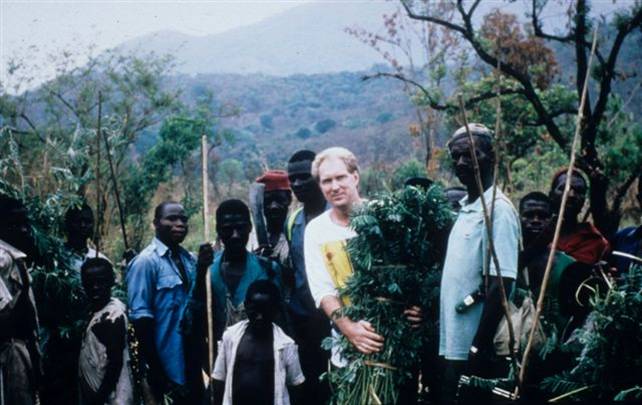Chester Zoo has been supporting conservation work in Gashaka Gumti National Park, Nigeria, since 1994. The park is a biodiversity hot-spot, and is the home to a huge variety of wonderfully diverse wildlife, including probably the last viable population of the Nigeria-Cameroon chimpanzee sub-species.
The main focus in the past has been on the apes in the area through the Gashaka Primate Project which was founded in 2000, but we have recently taken over the co-ordination of the project under the new title Gashaka Biodiversity Project (GBP). And we are in the process of setting up a Non-Government Organisation (NGO) called ‘Chester Zoo Foundation Nigeria’.
 Gashaka Primate Project protecting Nigeria-Cameroon chimpanzee sub-species – approximately only 1000 left in the wild
Gashaka Primate Project protecting Nigeria-Cameroon chimpanzee sub-species – approximately only 1000 left in the wild
The Gashaka Biodiversity Project will now expand and look more broadly at all of the wonderful species living in this habitat.
We are thrilled to be taking the lead on a project such as this, protecting a vast ecosystem with such a wide range of species. We will continue to work hard to protect it!
Chester Zoo has been working alongside national and international partners fighting to save the park and its wildlife from threats such as encroachment, fires and poaching.
 Our former director general, Gordon Reid, on Chester Zoo’s first expedition to Nigeria in 1994
Our former director general, Gordon Reid, on Chester Zoo’s first expedition to Nigeria in 1994
Main aims of the project
The Gashaka Biodiversity Project aims to protect the forest and the diverse fauna and flora living within it. We are looking forward to getting involved in the conservation work on the ground as well as further research which will contribute to our current understanding of Gashaka Gumti, the park management and the deterring of illegal activities.
We will work closely with the local communities within Gashaka, providing employment and training. Our field assistants are all from local communities and are crucial to the day to day running of the project. They are vital in helping control any illegal activities and making sure the forests are protected.

On top of building relationships we aim to carry out plenty of research as we still don’t know the extent of what wonderful animals are living in this habitat! And it’s a large area too – covering nearly 7000km2!

What’s next?
First things first! We need help in setting up our project headquarters in Serti, which is the nearest town to the park.
We have always worked closely with the National Park Service and are building our new headquarters close to their office in Gashaka Gumti so we can continue our close collaboration.
 Plot of land in Serti for Gashaka Biodiversity Project HQ
Plot of land in Serti for Gashaka Biodiversity Project HQ
Our new HQ will enable us to expand our work and make a real difference to the park and communities that live around it. As well as the project HQ we will be helping the National Park Service to develop the infrastructure in Gashaka Gumti to support tourism, communications and anti-poaching patrols. And on top of the building developments we will need to provide kit, equipment and resources for the visitor centre.
More about the park & the history of the project…
-571x381.jpg)
Gahsaka Gumti National Park is located in southeast Nigeria on the border with Cameroon and is the largest National Park in Nigeria. The main entrance to the park is Serti which is a 12 hour drive from the airport!
It was gazetted as a National Park in 1991, with the help of early pioneer Richard Barnwell, who has worked for many years with the World Wide Fund for Nature. He first arrived at Gashaka Gumti in 1972 working hard to establish the game reserves and employ anti-poaching measures.
The main objective of the park was to protect Nigeria’s varied ecosystems which were being threatened by encroachment and poaching. By 1978 there were 80 fully trained and equipped game guards, and it was well on its way to becoming a first class game reserve.
However, after he left in 1979, the following five years saw changes in senior staff and dwindling government funding meant that the reserves went into decline and poaching became prevalent again and wildlife population began to decline.
In 1991 the Nigerian Conservation Foundation alongside Richard (who was working for WWF by this time) worked to implement a new infrastructure which saw the recovery and restoration of Gashaka Gumti. It was declared a National Park that same year!